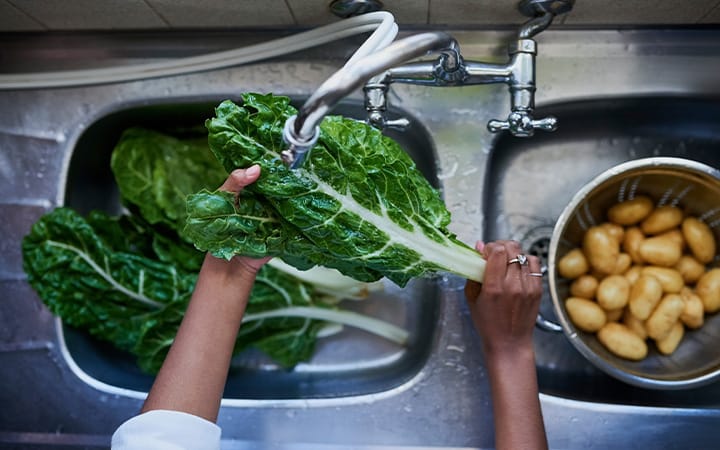Pesticides in Food: How to Reduce Your Risk
July 14, 2025

We all know that eating plenty of fruit and vegetables is an important part of a healthy diet. However, reports show that the produce we buy in grocery stores is often contaminated with pesticides.
While pesticides are important for protecting crops from pests and diseases, they have also been linked to a range of health conditions. While it may be impossible for most people to completely eliminate pesticide exposure, there are ways to help minimize the risk for you and your family, says Jacob Wolf, ND, LAc, a naturopathic doctor at University Hospitals Connor Whole Health.
What Are Pesticides?
Farmers use a wide range of chemicals to protect crops, including:
- Herbicides to control weeds. Glyphosate, the herbicide found in RoundUp, is the most common herbicide used in agriculture.
- Fungicides, which control fungi or fungal-like organisms, including rust, mildew and blight.
- Insecticides used to kill or repel insects that can damage crops.
- Disinfectants, which are used to control bacteria and microorganisms that can harm crops.
Pesticides can be found both on whole foods and in final products made from fruits, vegetables and grains. In most cases, chemicals are sprayed on crops during growth or harvest. These pesticides can penetrate beneath the surface through natural openings and can also work their way into foods when they are processed. According to the Environmental Working Group (EWG), pesticides have been detected in more than 70 percent of non-organic produce.
Pesticides are also very common in water sources, especially water sources near farms where food is grown. Some research shows up to 90 percent of streams are contaminated with varying amounts of pesticide.
How Does Pesticide Exposure Affect Your Health?
Pesticide exposure is associated with a wide range of symptoms, from minor to severe. Acute exposure symptoms may include:
- Allergy symptoms
- Rashes
- Nausea
- Diarrhea
Some pesticides can accumulate over time in the body. Chronic exposure may increase the risk of:
- Various types of cancer
- Nervous system changes
- Endocrine system and hormonal disruptions
- Immune system dysfunction
These risks are higher in more vulnerable populations, including children and infants, the elderly and people with chronic diseases. People who live in farming communities or near golf courses are also at risk of chronic exposure.
The Environmental Protection Agency (EPA) sets the maximum levels of pesticide residue allowed in food and water, while the FDA and U.S. Department of Agriculture monitor the actual levels in products. While the EPA determines what is considered a “safe” level of pesticides in food, less exposure is always better, says Dr. Wolf.
Ways to Reduce Pesticide Exposure
Some of the ways you can help reduce your pesticide exposure include:
- Buy organic produce and products when possible. While buying all organic products is ideal, it’s sometimes too expensive. Fortunately, there are some general guidelines to help you decide what is best to buy organic. The EWG’s annual Dirty Dozen guide identifies the 12 types of produce most likely to contain high amounts of pesticides. Fruits and vegetables on the Dirty Dozen include:
- Spinach and kale
- Strawberries, blackberries and blueberries
- Grapes
- Peaches and nectarines
- Cherries
- Apples and pears
- Potatoes
The EWG’s “Clean Fifteen” lists the produce with the least amount of pesticide contamination. It includes:
- Pineapples
- Sweet corn
- Avocados
- Papaya
- Onion
- Cauliflower
- Bananas
- Carrots
Dr. Wolf says the general rule of thumb is if you eat the whole fruit or vegetable – like berries, green beans or grapes – buy organic. If the fruit has a peel or skin you remove before eating – like citrus fruit or bananas – the conventionally grown variety is typically safe.
- Wash all your fruits and vegetables. This helps remove trace amounts of pesticides. Rinsing with plain water works well, but you can also soak in a vinegar and water bath or a baking soda and water solution before rinsing clean.
- Use a water filtration system in your household. The best water filtration systems use activated carbon or reverse osmosis.
Bottom Line: Eat More Fruits and Vegetables
Dr. Wolf says that making sure to include fruits and vegetables in your diet is more important than always buying organic.
“Most people don’t eat a fraction of the produce they should eat on a daily basis,” he says. “Eat produce first, select organic if you can and use the Dirty Dozen and Clean 15 as general guidelines for safety.”
You should aim to eat at least five servings of fruit and vegetables every day.
Related Links
At UH Connor Whole Health, we take the whole person into account, addressing the full range of physical, emotional, mental, social, spiritual and environmental influences that affect an individual’s health. This includes exploring diet and nutritional needs.


